Nestled up against the gentle slope of the Eastern Sierra, Nevada’s oldest town awaits—it just so happens to be one of those magic places that fosters some of the most authentic ways to engage with Nevada history, too. With a charming historic district lined with all the same structures that have always stood there for 170-years-and-counting, there are so many different ways to not merely visit Nevada’s oldest town, but become part of its story. With historic courthouses-turned-museums, sprawling late Victorian estates and architecture, the type of small-town shopping worth traveling for, fairs and festivals revered across the Silver State, and historic structures that celebrate the modern day Nevada origin story, there sure is plenty to see. And then? Then there’s the Genoa Bar.
Genoa Bar History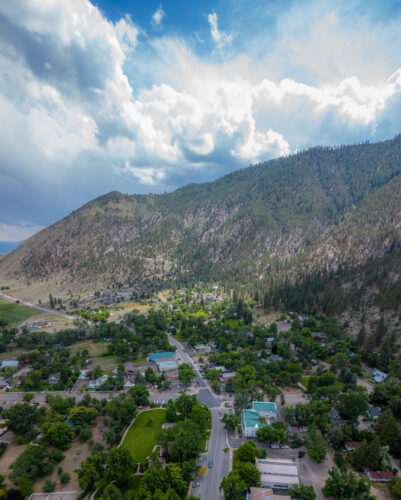
With an old historic bar as legendary as the Genoa Bar—one of Carson Valley (and Nevada’s!) top attractions, and a place that commands thousands of visitors each and every year—you might think it’s one of those places that’s turned into a total tourist trap. You know one of those that’s strayed so far from its roots it’s only authenticity is referencing the way it was long before you actually had the chance to experience it for yourself. Well, not here. Just like most of the rest of Nevada’s Great Basin, sometimes the best stuff is right there, hidden in plain sight, waiting for you to really see it in the most perfectly unpretentious way. What many once-grand frontier-town-type of destinations try and replicate today naturally exists in downtown Genoa, and has since it first opened all the way back in 1853.
Genoa, NV anchored the Nevada Territory scene in 1851—thirteen whole years before Nevada even became an official state. And despite being settled by Mormon missionaries on a quest to stake out the West, way back then it wasn’t uncommon for Joseph Smith followers to partake in alcohol consumption. In true Nevada fashion where just about every town began with a mine and a bar, even Genoa’s earliest (and moderately conservative) townspeople quickly realized they needed a bar. And so it was. In 1853, Genoa’s first, and most lasting bar opened as Livingston’s Exchange, but once it was sold and rebranded as a gentleman’s saloon to Frank Fettic in 1884, the saloon became Fettic’s Exchange.
Becoming Fettic’s Exchange, Genoa’s Swankiest Hangout
By the mid 1880s, a lot of the lawlessness that came along with being the first town in the state had ended when those early Mormon missionaries returned back to Utah and the world’s largest silver strike was discovered, which meant Genoa could attract an entirely new, upper crust sorta crowd. Now Genoa, NV was a destination for the social elite, who came to Nevada’s first official town to bask in luxuries over at David Walley’s Hot Springs resort, stay in some of the state’s first hotel properties, and of course enjoy a beverage—first-class style of course—at Fettic’s Exchange, which instead of slinging your typical old whiskeys, gins, and beers, served fine wines, liquors, and cigars. In other words, “no rough stuff” or excessive drinking-fuelled brawls around here.
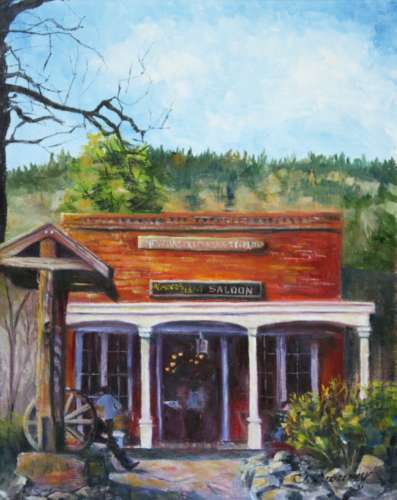
He also majorly classed the place up, bringing in all kinds of precious furniture and other swanked-out decorations that fostered the exact type of hangout area Comstock millionaires sought out, like a Diamond Dust Mirror—a mirror that’s made with bits of actual diamonds—that came all the way around the world from Glasgow, Scotland. Knowing this thing “went around The Horn” (or the very southernmost tip of South America) via ship then carted by wagon over the Sierra, well, it’s hard to believe it arrived in one piece, not to mention survived a devastating fire that swept through Genoa, but that part of the story comes later. Other first-class opulence included relics like a ceiling covered with fancy medallions, and red oil lamps, too.
Gentlemen Only, Ladies Forbidden
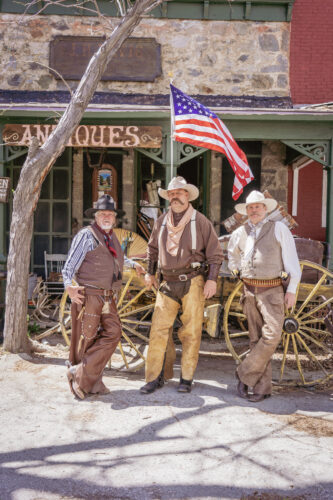 The bar was for men only of course—a typical societal norm way back then—though women could sit and wait in a partitioned corner, if they wanted to. It evolved from one of the only places to actually get a drink for dozens of miles to one of the region’s most opulent Thirst Parlors, and that reputation just sorta stuck. Even though women were not allowed to hang around and enjoy Fettic’s curated luxuries, legend has it that all kinds of famous men sure did, including Ulysses S. Grant, Theodore Roosevelt, and almost certainly Mark Twain, who of course became Mark Twain during his brief time in Nevada as Virginia City’s most celebrated writer.
The bar was for men only of course—a typical societal norm way back then—though women could sit and wait in a partitioned corner, if they wanted to. It evolved from one of the only places to actually get a drink for dozens of miles to one of the region’s most opulent Thirst Parlors, and that reputation just sorta stuck. Even though women were not allowed to hang around and enjoy Fettic’s curated luxuries, legend has it that all kinds of famous men sure did, including Ulysses S. Grant, Theodore Roosevelt, and almost certainly Mark Twain, who of course became Mark Twain during his brief time in Nevada as Virginia City’s most celebrated writer.
Unsuspectingly, Fettic ran Genoa’s finest drinking establishment for almost five whole decades, from 1884 up until 1933 when he passed away. If you stop to think about how much Genoa, and all of Nevada changed during those few decades, well, the answer is a lot. He’d seen, and helped Genoa change from the definition of a true gunslingin’ frontier town to a place of order and refinement, and even moonlighted the saloon as a soda fountain to get through a decade of national prohibition there in the end. Fettic’s Exchange also miraculously withstood a catastrophic fire that leveled at least two whole blocks of downtown Genoa homes and businesses that stood right around the bar.
The Oldest Bar on the Silver Screen: “No Horses Allowed”, except for that one Coors Commercial
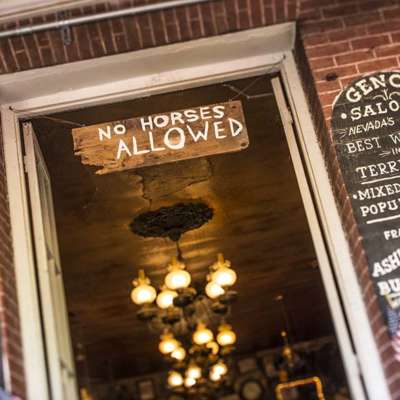
Through the years, the Genoa Bar changed hands at least three different times, all the way up until 1963 when Robert and Betty Carver got ahold of the original 1853 bar structure, and renamed it the Old Genoa Bar. From 1933 (the year Fettic departed) all the way up until Carver took ownership, Nevada’s oldest bar had lost its luster, but the Carvers work helped resolidify its reputation and its unmistakable place in the Nevada history books for good.
Even though a bunch of famous politicians ranging from United States Presidents to Nevada Governors had visited the Old Genoa Bar in its early years, it wasn’t until the 60s and 70s that the bar really caught the attention of Hollywood filmmakers and celebrities alike. Legend has it that the Old Genoa Bar was a favorite hangout for Carol Lombard and Clark Gable, along with Lauren Bacall and Richard Boone, among many more.
The Genoa Bar has also made a dreamy backdrop for many movies, television shows, and commercials like John Wayne’s The Shootist (his last ever movie, btw), Honky Tonk Man featuring Clint Eastwood, the movie Misery, and ‘Till the River Runs Dry, to name a few. Later in the 1980s, the Genoa Bar was featured in a Coors Beer commercial, where story has it that the actors preferred the taste of Budweiser beer and filled the Coors cans shown in the ad with Bud beer. Whether that’s true or not we’re not sure, but it sure is fun to imagine as you’re drinking a cold one at the Genoa Bar today.
By the year 2000, the Carvers had their sights set on retirement, and the bar changed hands another time to the Genoa Bar’s current owners, Willy and Cindy Webb, who have been running this historic haunt all seven days a week in the decades since.
Experiencing Nevada’s Oldest Bar Today
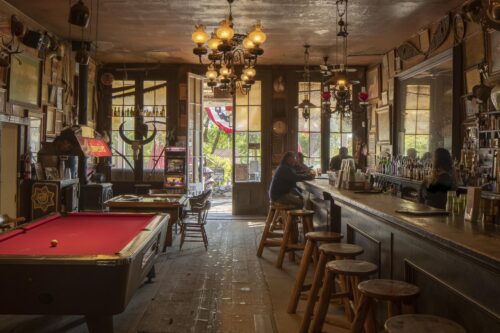 So what’s it like to experience the Oldest Thirst Parlor in the Silver State, you ask? Like hiking the tallest summit peak or staying in the oldest hotel, ordering up a cold one that’s served over the same wooden bar counter that’s remained here since 1853 is one of those deals that, in the simplest way, is better if you live it for yourself.
So what’s it like to experience the Oldest Thirst Parlor in the Silver State, you ask? Like hiking the tallest summit peak or staying in the oldest hotel, ordering up a cold one that’s served over the same wooden bar counter that’s remained here since 1853 is one of those deals that, in the simplest way, is better if you live it for yourself.
Once you’re ponied up to that old bar counter, just about everywhere you look you’ll spot a relic that comes along with a story that’s best told by the bartendress on a random ol’ Tuesday when it’s just you, and her. Back behind that weathered bar counter hangs the diamond dust mirror that made it all the way from Scotland almost two centuries ago, along with that original red oil lamp dangling overhead—the only one in the place that hasn’t been converted over to electrical, and is lit only one day a year, on New Year’s Eve. Expect plenty of naked lady paintings covering all the walls, cobwebs-covered window patina that’s been there since the 1850s, low door knobs on tall doors, racks of antlers with a very famous bra dangling from it (another story to ask the bartendress), a rusted-out safe just barely creaked open for inquiring minds, and if you’re there in the wintertime, a roaring old potbelly stove to cozy up next to.
And if your visit brings you to Carson Valley in the summertime, well then order up one of those “famous” Genoa Bar Bloody Mary’s, pick out your favorite spot on that wooden boardwalk-lined porch out front and raise a glass to ol’ Fettic, and all the other decades of Carson Valley characters who’ve kept the Genoa spirit alive and well.
For even more great reads about the Carson Valley food and drink scene, click here.



